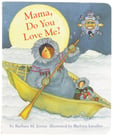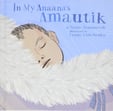In January, we focus on the Arctic with our preschoolers. It is a time of cold things, freezing places, wintery animals and interesting culture - and our people of focus this month are those that inhabit the far reaches of the North: the Inuit.
| Artic Language List | Character Cards | Chinese Writing Practice | Songs | Arctic Stories |
| All about the Arctic | Banner & Display Pack | Arctic Animals | Arctic Activities | More activities |

The Inuit Snow glasses. It has been used to protect their eyes from snowstorms and bright light of snow and sun




Inukshuk sculptures were very popular in Inuit communities and culture

The Importance of Preschool Education in Inuit Culture
Preschool education plays a crucial role in Inuit culture, providing a strong foundation for children's development and understanding of the wider world around them. It prepares them for future learning and helps them acquire essential skills and knowledge through playful learning.
Inuit children are encouraged to explore their environment and engage in hands-on activities that promote their cognitive, social, and emotional development. Through play-based learning, they develop problem-solving skills, creativity, and critical thinking abilities. Preschool education also helps Inuit children develop strong language and communication skills, which are vital for their overall development.
Inuit culture places great importance on the concept of 'inuuqatigiitsiarniq,' which means 'to become a complete person.' Preschool education plays a significant role in nurturing the holistic development of children, helping them become well-rounded individuals who are connected to their community and culture.
Traditional Teaching Methods Passed Down Through Generations
Inuits embrace traditional teaching methods that have been passed down through generations. Elders and community members play a vital role in imparting knowledge and wisdom to the younger generation. They share stories, legends, and traditional practices that help children develop a deep understanding and appreciation for their cultural heritage.
Oral storytelling is an essential part of Inuit education. Through storytelling, children learn about their history, values, and beliefs. They also gain a sense of identity and belonging as they connect with their ancestors' experiences. Traditional games, songs, and dances are incorporated into the curriculum to engage children and teach them important life skills.
By preserving and passing on traditional teaching methods, Inuit preschools ensure the continuity of their cultural practices and promote a strong sense of cultural identity among the younger generation.
Incorporating Cultural Traditions of Inuit
Inuit place a strong emphasis on incorporating cultural traditions into their curriculum through clothing and ways of living. Children are exposed to Inuit art, crafts, and traditional practices to develop an appreciation for their cultural heritage. They learn about traditional hunting and fishing methods, clothing, and food preparation techniques.
Inuit language, known as Inuktitut, is also an integral part of preschool education. Children are taught basic vocabulary, phrases, and expressions, helping them develop a strong connection to their language and community. Bilingual education programs are implemented to ensure the preservation of the Inuit language while also providing children with the necessary English language skills.
By immersing children in their cultural traditions and language, Inuit preschools aim to foster a sense of pride and belonging among the younger generation.
For parents looking to expand their repertoire of January activities for toddlers, exploring a variety of winter-themed engagements can be beneficial. For a comprehensive list of exciting winter activities, you can refer to our detailed guide here: January activities for toddlers.
Promoting Cultural Identity and Language Preservation
One of the primary goals of Inuit education is to promote cultural identity and language preservation. Inuit children are encouraged to embrace their cultural heritage and develop a strong sense of identity.
Inuits create a culturally inclusive environment where children can freely express their Inuit identity. They celebrate cultural events, festivals, and traditional practices, fostering a sense of belonging and pride. Inuit language is integrated into daily activities and conversations, ensuring its preservation and usage among the younger generation.
Teaching Diversity of Inuit culture through stories
Mama, Do You Love Me? - This beloved story of a child testing the limits of her independence, and a mother who reassuringly proves that a parents love is unconditional and everlasting is a perfect first book for toddlers. All times favourite for our youngest readers and a subtle way of introducing concept of difference in people's livelihoods.
In My Anaana's Amautik - Nadia Sammurtok lovingly invites the reader into the amautik―the pouch in the back of a mother’s parka used to carry a child―to experience everything through the eyes of the baby nestled inside, from the cloudlike softness of the pouch to the glistening sound of Anaana’s laughter. Sweet and soothing, this book offers a unique perspective that will charm readers of all ages.
Tags:
January, Dragon Flight, diversity and inclusion, Educational Activities, understanding the world, multicultural
21-Dec-2023 11:03:06
Related Articles







Write a Comment